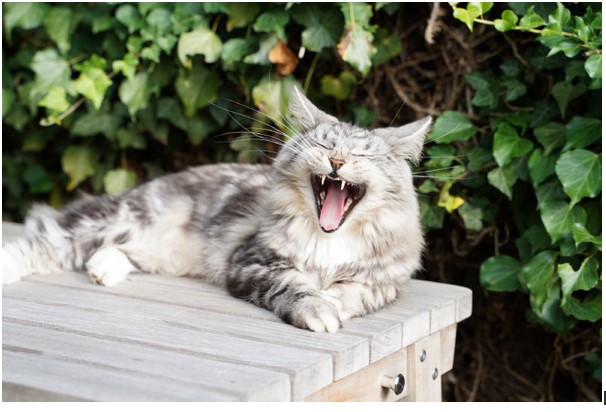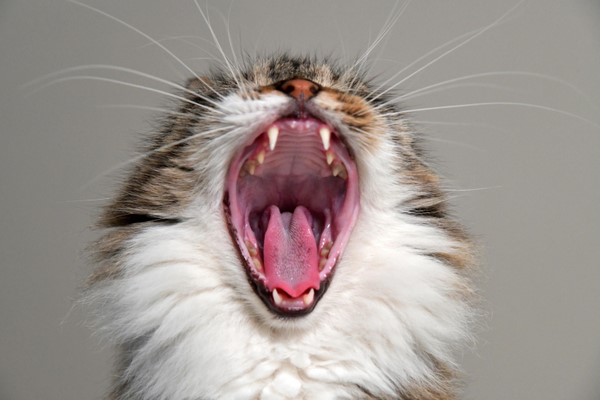
The mere suggestion of attempting to clean your cat’s teeth may conjure up images of bone-deep scratches, but it doesn’t have to end that way! Follow our top ten tips for cleaning your cat’s teeth to ensure you and your cat remain on good terms.
Did you know eight in ten cats over the age of three suffer from teeth and gum problems? Left untreated, plaque and tartar build-up in your cat’s mouth which can lead to more severe dental disease and often results in the extraction of teeth.

Dental disease in cats usually presents with some of the following symptoms:
- Bad breath (cats naturally have a bit of a fishy breath, but a strong, foul odour is a sign of dental disease)
- Drooling
- Bleeding gums or bleeding from the mouth when eating dry food
- Difficulty eating or eating only on one side of their mouth
- Mild swelling of the face
- Red or angry-looking gums
- Lack of appetite
- Failing to groom or looking unkempt
- Loose or missing teeth
Ideally, you should start brushing your cats teeth when they are still a kitten, but it is better late than never! So without further ado, our top ten tips on how to clean your cat’s teeth!
1. Check In With Your Vet
This is especially important if your cat is already a few years old. A trip to the vet to have your cat’s teeth examined and to check if they require a deep clean under anaesthetic to clean away any plaque or tartar that has accumulated on your cat’s teeth. Your vet can also provide advice on products and the best way to brush your cat’s teeth.
2. Be Prepared
Products you will need to keep those pearly whites sparkling include:
- A toothbrush just for cats (you can’t use a human toothbrush, they are too big and the bristles are too hard for your cat’s teeth)
- If you don’t want to use a toothbrush, you can buy special wipes that you wrap around your finger or sterile gauze will also do the job
- Toothpaste just for cats which often comes in tempting flavours like beef or chicken. Again, human toothpaste is not suitable and can make your cat very sick.
3. Get Comfy
Don’t try to brush your cat’s teeth when they are agitated or hungry. Pick a time of day when they are relaxed. Establishing a routine by brushing at the same time each day can also be comforting to your cat. Let your cat sniff, chew or taste the brush, wipes and toothpaste. Practice touching around your cat’s mouth, their lips, gums and teeth.
4. Purrito Time!
Some cats may be more comfortable wrapped snugly in a towel or blanket. It can also be safer for you to have those claws tucked away! Some cats might not be a fan of the purrito and may prefer to be in your lap or on a table.
5. Assume the Position
Gently hold your cat’s head with your non-dominant hand and use your fingers to pull back their lips, exposing their teeth.
6. One at a Time
Give one or two teeth a wipe over with your finger or a toothbrush in a circular motion on the surface of the tooth that faces the inside of your cat’s cheek. Clean right up to the gum line, and give the gum a bit of a massage as well.
7. Bribes are OK
If your cat seems uncomfortable with you being in their mouth, try dipping your finger or the toothbrush in tuna juice or their favourite creamy treat to entice them into opening wide.
8. Take it Slow
If your cat is extremely resistant to your attempts to brush their teeth, don’t force things or you may find them even more hard to handle next time you try.
9. Reward, Reward, Reward
Shower your cat in praise after each attempt at brushing - successful or not! Show them that tolerating brushing equals play time with their favourite toy or that they will be rewarded with their favourite treat.
10. Keep up the Good Work!
Keep practicing brushing regularly and once your cat accepts the brushing without much of a fight, you should try to clean their teeth once daily or at least every second day to keep those whites looking pearly and their breath fresh!

If your attempts to brush your cats teeth only ends in you not talking for days or weeks on end, there are other ways you can help prevent the buildup of plaque and tartar.
You can feed your cat specialty dental or oral care food from brands such as Advance or Hill’s or your vet can recommend either the Hill’s Prescription Diet or Royal Canin Veterinary Diet dental food.
Dental sprays are a liquid solution that is sprayed onto your cat’s teeth that can help prevent the buildup of plaque and tartar in your cat’s mouth. Water additives are also useful at helping to prevent that buildup and are added daily to fresh water and we stock quality brands such as Aquadent and Prozym.
Dental treats like Greenies have a unique teeth-cleaning shape and help to freshen your cat’s breath.
View all dental products for cats here.
